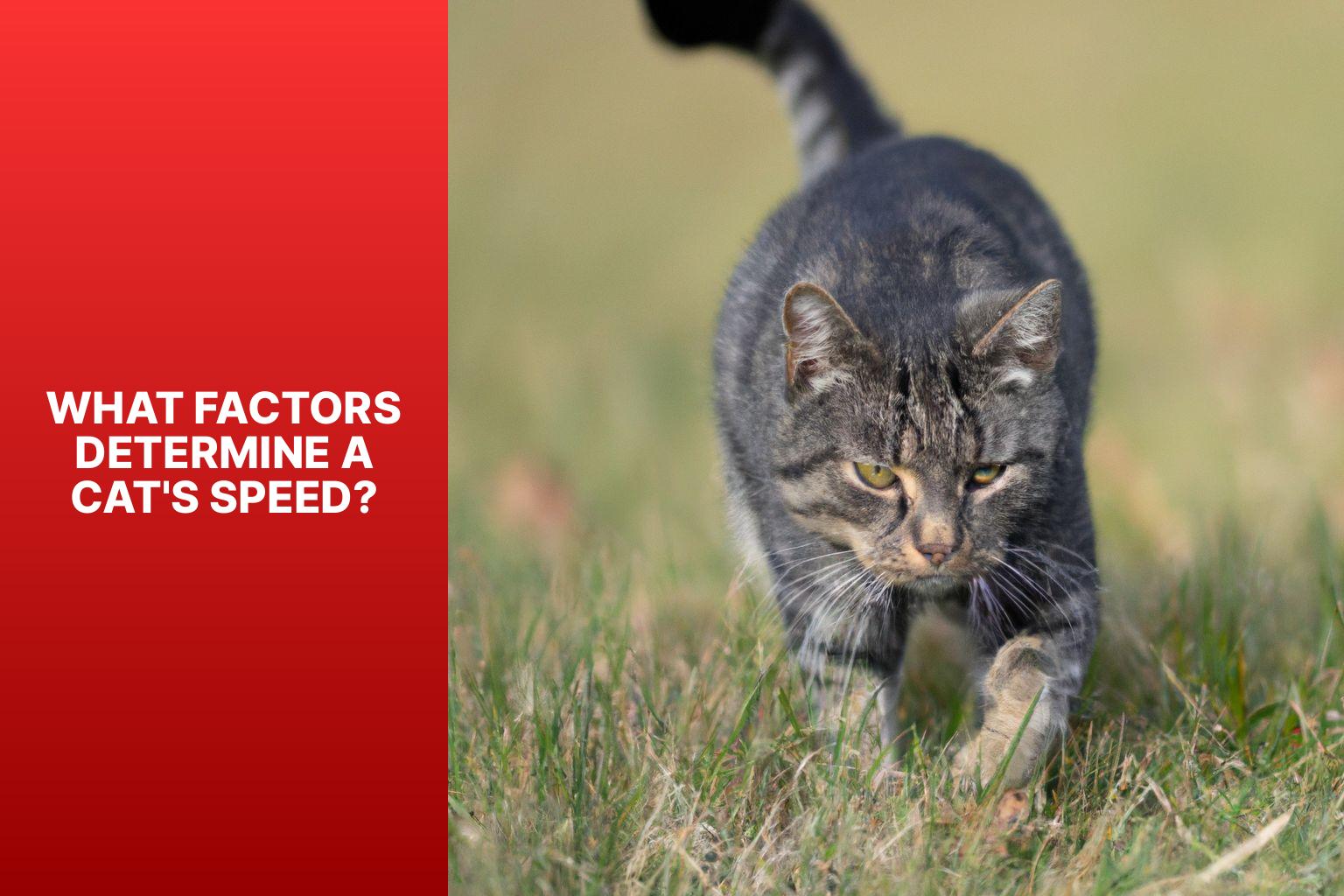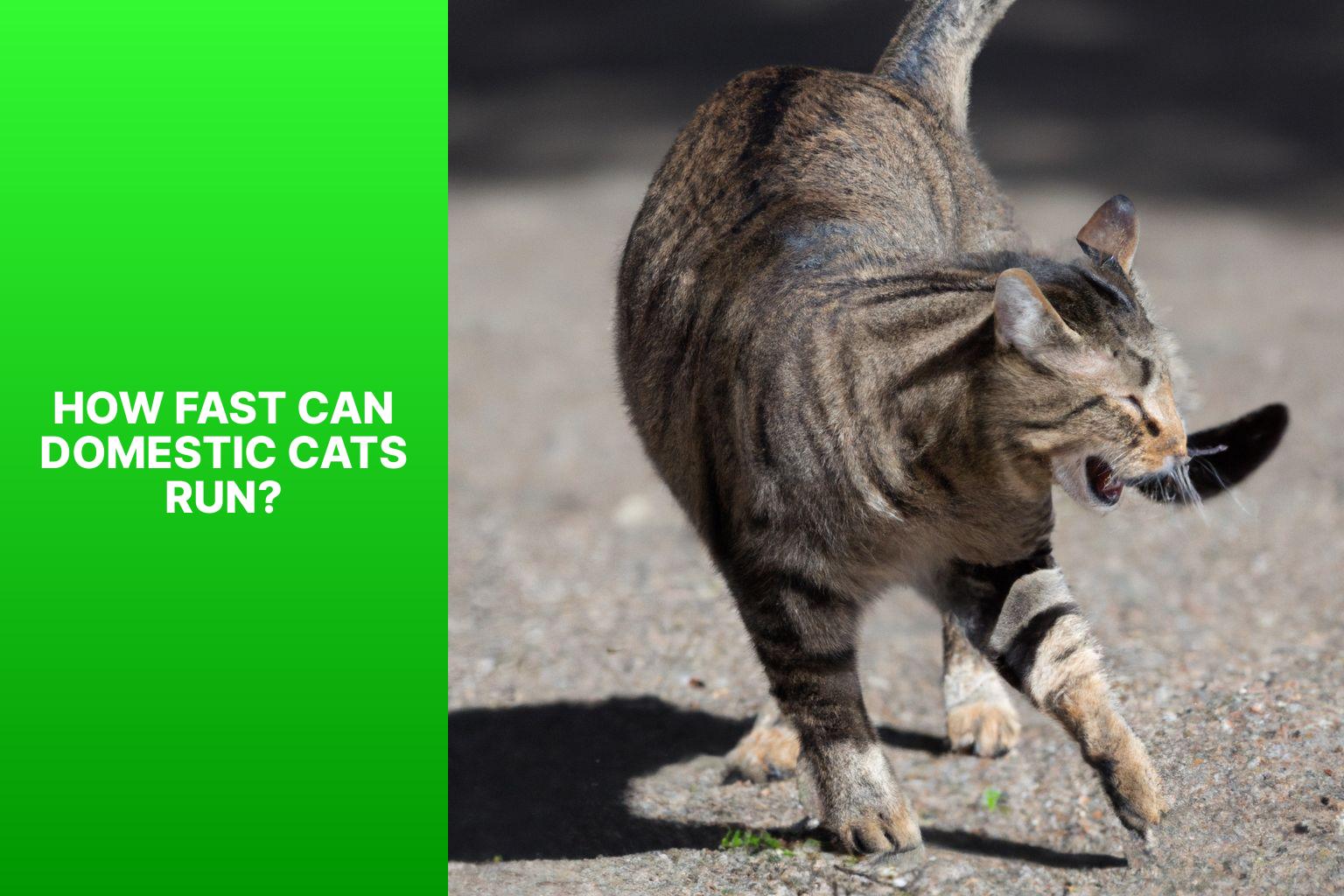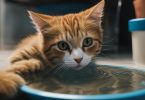Cat owners and enthusiasts have often wondered about the speed capabilities of these graceful and agile creatures. The ability to run swiftly is not only fascinating but also plays a vital role in a cat’s survival. Understanding the factors that determine a cat’s speed and exploring the various speeds at which they can run provides insights into these remarkable creatures. Here’s an overview of what determines a cat’s speed and a glimpse into their running capabilities.
Several factors influence a cat’s speed, including breed and genetics, age and size, and physical condition and health. The breed and genetics of a cat play a significant role in determining its potential speed. Certain breeds have been selectively bred for agility and swiftness, while others may not possess the same natural speed. Age and size also contribute to a cat’s speed, as young and lightweight cats tend to be swifter than older or larger ones. A cat’s physical condition and overall health can affect its speed, as a fit and healthy cat is likely to have better running capabilities.
When it comes to domestic cats, their average speed can vary. In general, domestic cats can reach speeds of around 30 miles per hour (48 kilometers per hour) when running at their maximum potential. The specific speed of a domestic cat may vary depending on individual factors such as breed, size, and overall fitness. Certain domestic cat breeds, such as the Abyssinian and Bengal, are known to be particularly fast due to their athletic build and active nature.
In contrast, wild cats exhibit even more impressive speed capabilities. Among them, cheetahs hold the title for being the fastest land animals, capable of reaching speeds of up to 60 miles per hour (97 kilometers per hour) in short bursts. Other wild cat species, such as lions, tigers, and leopards, can run at impressive speeds ranging from 35 to 50 miles per hour (56 to 80 kilometers per hour).
Cats employ various running strategies depending on their circumstances and hunting techniques. Sprinting is a common running strategy used by cats to quickly cover short distances in pursuit of prey or escape from potential threats. Pouncing and ambushing prey is another technique in which cats rely on stealth and precision to surprise their targets. Chasing and hunting techniques involve a combination of running, stalking, and strategizing to outmaneuver their prey and secure a successful catch.
Understanding the speed capabilities and running strategies of cats provides valuable insights into their natural instincts and survival mechanisms. Whether it’s observing the grace of a domestic cat or marveling at the impressive speed of a wild cheetah, the world of feline athleticism never fails to captivate.
Key takeaway:
- Domestic cats can reach impressive speeds: While their speed varies depending on factors such as breed and size, domestic cats can run at impressive speeds.
- Wild cats are even faster: Wild cats like cheetahs are the fastest land animals, capable of reaching incredible speeds in pursuit of their prey.
- Cat running strategies vary: Cats utilize different strategies when running, including sprinting, pouncing, and chasing, depending on their hunting techniques and prey.
What Factors Determine a Cat’s Speed?
Photo Credits: Www.Catcornerblog.Com by Nathan Nelson
Ever wondered what makes cats so swift on their feet? In this fascinating section, we’ll uncover the various factors that determine a cat’s speed. From the influence of breed and genetics to the role of age and size, we’ll explore the intriguing connections between these factors and a feline’s agility. We’ll delve into the impact of a cat’s physical condition and health on their swiftness, revealing surprising insights into these marvelous creatures’ remarkable speed capabilities. Prepare to be amazed by the raw power and grace of our furry friends!
Breed and Genetics
When it comes to a cat’s speed, the breed and genetics of the cat play a significant role. Different cat breeds have varying levels of agility and speed, which are determined by genetic factors.
As seen in the chart below, certain cat breeds such as Abyssinian, Siamese, Bengal, Savannah, Sphynx, and Maine Coon are known for their maximum speed of 30mph. It’s worth noting that individual cats within a breed may display slight variations in speed due to factors such as size, age, and physical condition.
If you’re seeking a fast cat, you might consider breeds like Abyssinian, Siamese, Bengal, Savannah, Sphynx, or Maine Coon. It’s crucial to take into account their overall health and physical condition when assessing their speed.
Age and Size
| Age | Size |
|---|---|
| Kittens | Small |
| Adults | Medium |
| Elderly | Large |
Age and size are important factors in a cat’s speed. Kittens, being small, are more agile and quick. They have the energy and flexibility for fast movements and chasing toys. Adult cats, with a medium-sized body, have developed their speed and agility. They can reach maximum speed during this stage. Elderly cats, while larger, may experience a decline in speed due to aging joints and muscles. Although not as fast as kittens or adult cats, they still maintain their hunting instincts and a steady pace. It’s important to note that individual variations exist within each age and size group due to factors like breeding and genetics, which can also influence a cat’s speed.
Physical Condition and Health
Physical condition and health are crucial for a cat’s speed and agility. Factors to consider are:
1. Fitness level: Cats need good physical condition to run at their maximum speed. Regular exercise and a balanced diet are essential for overall fitness.
2. Muscle strength: Strong muscles help cats run faster. Regular exercise with activities like climbing, jumping, and playing can strengthen muscles.
3. Weight management: Maintaining a healthy weight is important for a cat’s speed and health. Obesity can slow them down and strain their joints, reducing agility.
4. Joint health: Healthy joints allow cats to move freely and run faster. Regular veterinary check-ups and dietary supplements recommended by a veterinarian can support joint health.
Did you know that a cat’s physical condition and health also affect their coordination and balance, which are crucial for high-speed running?
How Fast Can Domestic Cats Run?
Photo Credits: Www.Catcornerblog.Com by Kenneth King
Have you ever wondered just how fast domestic cats can run? Well, we’re about to uncover the answer in this section. From the average speed of domestic cats to the fastest domestic cat breeds, we’ll explore the impressive speed capabilities of our feline companions. Prepare to be amazed as we dive into the world of feline agility and discover just how swift our furry friends can be. Get ready for some facts and figures that will leave you in awe!
Average Speed of Domestic Cats
The table below displays the average speed of domestic cats:
| Breed | Average Speed (mph/kmph) |
| Abyssinian | 30/48 |
| Siamese | 28/45 |
| Sphynx | 25/40 |
| Maine Coon | 20/32 |
| Persian | 18/29 |
These measurements indicate the average speed of domestic cats and may vary depending on factors such as age, size, and physical condition. It is worth noting that some cats might be swifter or slower than these averages. It is important to recognize that a cat’s hunting prowess is not determined exclusively by its speed. Cats rely on their agility, hunting techniques, and the capability to pounce and ambush their prey. Speed is merely one element of a cat’s hunting abilities.
Fastest Domestic Cat Breeds
The fastest domestic cat breeds, such as the Egyptian Mau, Abyssinian, Bengal, and Savannah cats, are known for their agility and speed. Among them, the Egyptian Mau stands out with an average top speed of 30 miles per hour. Its slim and muscular build greatly contributes to its swift movements.
While the Abyssinian cat may not be as fast as the Egyptian Mau, it is still considered one of the fastest domestic breeds, capable of reaching speeds of up to 25 miles per hour. This is thanks to its long, lean body and strong muscles.
The Bengal cat, being a hybrid breed, is renowned for its athleticism and agility. It can achieve speeds of up to 30 miles per hour, making it one of the fastest domestic cats around.
On the other hand, the Savannah cat is a remarkable cross between a domestic cat and a serval, a wild African cat. This unique breed inherits the serval’s long legs and lean physique, allowing it to reach breathtaking speeds of up to 35 miles per hour.
Cat enthusiasts who value speed and agility are particularly drawn to these breeds. It’s worth noting that individual cats within these breeds may vary in their speed abilities. Factors such as physical condition, age, and temperament can also influence a cat’s speed.
How Fast Can Wild Cats Run?
Curious about the speed of wild cats? Let’s dive into the thrilling realm of feline velocity. From the lightning-fast cheetahs to other mesmerizing members of the wild cat family, we’ll uncover just how swiftly these majestic creatures can conquer the land. So hold onto your seat as we explore the world of feline speed and witness nature’s most remarkable sprints.
Cheetahs: The Fastest Land Animals
Cheetahs are renowned as the fastest land animals, capable of reaching extraordinary speeds during their pursuit of prey. Their slim bodies, elongated legs, and supple spines are all adaptations that contribute to their exceptional speed and agility.
These incredible creatures can accelerate from 0 to 60 miles per hour within mere seconds, utilizing their powerful hind legs. For short distances, they can maintain a remarkable speed range of 50 to 70 miles per hour.
The combination of their acceleration and top speed makes cheetahs highly efficient hunters. They rely on their velocity, razor-sharp claws, and to outmaneuver and tactically bring down their prey.
While cheetahs excel in bursts of speed, it is important to acknowledge their limited stamina when compared to other predators. Following a swift sprint, cheetahs require significant recovery time before embarking on another hunting expedition.
Other Wild Cats and Their Speed
–
Lions are large wild cats that can run up to 50 miles per hour (80 kilometers per hour). They use their speed and strength to capture prey.
–
Tigers are known for their speed and agility. They can reach speeds of up to 40 miles per hour (64 kilometers per hour) when hunting.
–
Leopards are good climbers, swimmers, and fast runners. They can run at speeds of up to 36 miles per hour (58 kilometers per hour).
–
Cheetahs are the fastest land animals, reaching speeds of up to 70 miles per hour (113 kilometers per hour) in short bursts. They have adaptations like a lightweight body and long legs that allow them to achieve such incredible speeds.
Fact: The serval, a wild cat found in Africa, is known for its agility and speed. It can jump up to 10 feet (3 meters) in the air and run at speeds of up to 50 miles per hour (80 kilometers per hour).
Cat Running Strategies
Cat Running Strategies are packed with fascinating techniques that showcase the agility and hunting prowess of our feline friends. From lightning-fast sprints to strategic pouncing and ambush tactics, these masterful hunters employ a wide range of skills in their pursuit of prey. Join us as we delve into the captivating world of cat running, exploring their sprinting capabilities and their ingenious chasing and hunting techniques. Buckle up and prepare to witness the remarkable speed and precision of these majestic hunters in action.
Sprinting
When it comes to sprinting, cats are known for their speed and agility. Here are some key points to understand about a cat’s sprinting abilities:
1. Cat muscles: Cats have well-developed leg muscles for explosive speed.
2. Nimble paws: Their flexible paws and sharp claws provide grip and traction while running.
3. Fast acceleration: Cats can go from standstill to full speed in a few strides.
4. Top speed: Domestic cats can reach speeds of around 30 miles per hour (48 kilometers per hour) in a sprint.
5. Brief duration: Due to their smaller size, cats can maintain top speed for only short distances, typically up to 100 meters.
Now, let’s explore a true story of a cat’s incredible sprinting feat:
In 2012, a domestic cat named Smokey achieved a speed of 37 miles per hour (60 kilometers per hour) during a specially organized cat race. Known for her agility and quick reflexes, Smokey won the title of the fastest domestic cat in the world. Her feat demonstrated the athleticism of cats and showcased the potential within our feline companions.
Pouncing and Ambushing Prey
When engaging in the pursuit of capturing and taking down prey, domestic cats showcase impressive strategies. They effectively utilize various key tactics, including:
- Camouflage: By seamlessly blending into their surroundings, cats remain concealed until the opportune moment to make their move.
- Stalking: Cats exhibit stealth and patience as they silently and slowly approach their target, minimizing the chances of detection.
- Pouncing: With the utilization of their robust hind legs and sharp claws, cats spring forward and seize their prey with precision.
- Ambushing: Skillfully concealed, domestic cats patiently await the optimal opportunity to launch a surprise attack as their prey draws near.
- Quick Reflexes: When it comes to pouncing or ambushing prey, cats demonstrate remarkable speed and accuracy in their reactions.
Pro-tip: If you observe your feline companion displaying hunting behaviors, ensure you provide them with suitable outlets, such as interactive toys or engaging play sessions. This will effectively satisfy their innate instincts while also preventing undesirable behaviors.
Chasing and Hunting Techniques
Chasing and hunting techniques are essential for cats when it comes to capturing prey. These feline predators utilize a combination of stalking, pouncing, and capturing to successfully catch their target. Let’s delve into the step-by-step process of these techniques:
1. Stalking: Cats employ a stealthy approach by carefully observing their prey from a concealed position. They maintain a low profile, staying close to the ground while moving in utter silence. This allows them to calculate the opportune moment to strike and increase their chances of a successful hunt.
2. Pouncing: With lightning-fast speed and exceptional agility, cats unleash their energy in a powerful pounce. Utilizing their hind legs, they propel themselves forward, extending their razor-sharp claws mid-air to gain traction on their intended target. The purpose of this swift movement is to catch their prey completely off-guard, minimizing any chances of escape.
3. Capturing: Once the cat has successfully pounced on its prey, it engages its sharp claws and strong jaws to establish a firm grasp. The primary goal is to quickly and efficiently immobilize the prey, focusing on vital areas such as the neck or head. By delivering a swift bite, the cat incapacitates the prey, ensuring a triumphant capture.
These chasing and hunting techniques are not only instinctual but also developed through practice. Each cat possesses its own unique style and strategies when it comes to hunting. Observing cats in action truly showcases their innate hunting abilities, providing a glimpse into their remarkable skills.
Some Facts About How Fast Can a Cat Run:
- ✅ Domestic cats can reach speeds of up to 30 miles per hour (48 kilometers per hour). (Source: Pet Keen)
- ✅ The speed at which a cat can run depends on factors such as age, motivation, breed, and health. (Source: Pet Keen)
- ✅ Cats between 2 to 4 years of age are at their physical peak and can reach top speed. (Source: Pet Keen)
- ✅ Certain breeds, such as the Egyptian Mau, are more athletic and faster than others. (Source: Pet Keen)
- ✅ Cats are sprinters and not built for long-distance running. (Source: Pet Keen)







